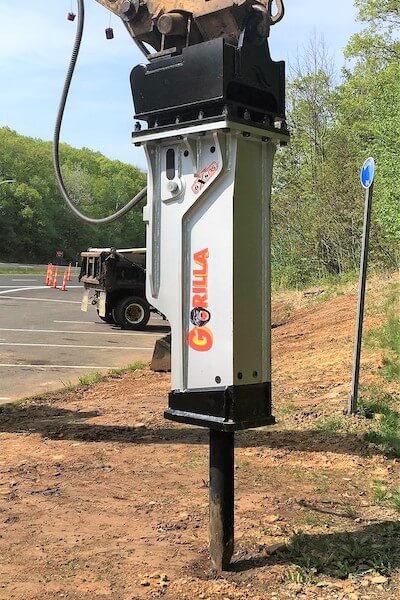Introduction
In the world of construction, efficiency and productivity are the cornerstones of a successful project. One essential piece of equipment that plays a pivotal role in achieving these goals is the hydraulic hammer, an excavator attachment that can make or break your workday. Selecting the right hydraulic hammer size for your heavy machinery is crucial, as it significantly affects the job requirements, material hardness, production rates, and application suitability of your project.
Understanding Hydraulic Hammers
A hydraulic hammer, often referred to as a breaker, is a powerful percussion hammer fitted to an excavator used for demolishing concrete structures or breaking rocks. Its operation is relatively straightforward – hydraulic fluid pressure is converted into impact energy, which then drives the hammer to deliver a powerful strike.
The hydraulic hammer consists of several components, including the housing, piston, and tool bit. The housing protects the inner parts, the piston provides the striking force, and the tool bit is the part that comes into direct contact with the material being broken.
Parameters for Choosing the Right Hydraulic Hammer
The process of selecting the right hydraulic hammer involves understanding your job requirements, the hardness of the material you’ll be working with, your expected production rates, and the suitability of the hammer for your specific application.
For example, if your work involves breaking concrete, high-frequency hydraulic hammers are recommended, with the specific size depending on the scale of your project. In contrast, breaking larger and harder materials may require larger hydraulic hammers with greater impact energy.
Hydraulic Hammer Sizing Based on Work Type
Hydraulic hammers come in small, medium, and large sizes, each suited to different types of work. Small hydraulic breakers are used for light-duty work such as breaking concrete, while medium breakers are versatile, handling both concrete and rock applications with certain size and material limitations. Large breakers, on the other hand, are designed for heavy-duty tasks, such as large scale concrete demolition projects or breaking through rock.
Excavator Compatibility
It’s crucial to match the hydraulic hammer size with the excavator to avoid potential damage to the breaker or the hydraulic system. A hammer that’s too small for your excavator can lead to inefficiency, while a too large breaker can cause overheating, instability, and structural issues. Always ensure that the weight of the breaker does not exceed the maximum lifting capacity of the carrier at any position for optimal productivity.
Hydraulic System Capacity
Understanding the hydraulic and pressure requirements of your hydraulic hammer is crucial. It’s essential to ensure that the oil flow to the breaker is within the specified range. This means you should be aware of your hydraulic system’s capacity and adjust it accordingly to avoid any potential damage or inefficiency.
Working Conditions
The environment where you’ll be using your hydraulic hammer can significantly affect its performance. For instance, special accessories may be required for working underwater or in dusty environments. Always assess your working conditions and choose a hydraulic hammer equipped to handle them.
Noise Level and Vibration Control
Hydraulic hammers can generate significant noise and vibration, which can be detrimental to operator comfort and safety. Hence, consider the noise level and vibration control features of the hydraulic hammer you’re planning to use.
Maintenance Requirements
Regular maintenance is key to extending the longevity of your hydraulic hammer. This can involve tasks like regular greasing, which can be made easier with automatic or centralized greasing systems.
Safety Features
Safety should always be a priority when working with heavy machinery. When choosing a hydraulic hammer, consider safety features such as built-in vibration control and noise reduction technologies. However, keep in mind that safety extends beyond the machinery itself – it also involves the proper use and handling of the equipment.
Understanding Breaker Technology
The technology behind hydraulic hammers is fascinating, particularly when it comes to the impact force and strike frequency. The impact force is the amount of energy delivered by the hammer to the material being broken, while the strike frequency refers to the number of strikes the hammer delivers per minute. Both of these factors are influenced by the size and specifications of the hydraulic hammer, as well as the hydraulic system’s capacity.
Measuring Equipment Specifications
When assessing hydraulic hammers, key equipment specifications to consider include the tool diameter, breaker weight, operating weight, and breaker class. The tool diameter is the width of the tool bit that interacts directly with the material being broken. The breaker weight refers to the weight of the hydraulic hammer itself, while the operating weight includes the weight of the carrier machine. The breaker class, on the other hand, is a categorization based on the hammer’s weight, energy class, and other specifications.
These specifications can guide you in choosing a hydraulic hammer that is compatible with your excavator, suitable for your job requirements, and appropriate for your working conditions.
We’re Here to Help
Choosing the right hydraulic hammer size is a complex process that requires a thorough understanding of your project needs, equipment specifications, and safety considerations. By taking these factors into account, you can ensure that you select a hydraulic hammer that boosts your productivity, maintains your equipment’s longevity, and ensures a safe and efficient work environment. Of course, Merc Hammer Group is here to support you. Our experienced team is dedicated to providing top-quality hydraulic hammers, servicing, and equipment, ensuring that you are equipped with the best tools for any project. Don’t hesitate to reach out to us for assistance with any of your hydraulic hammer needs, from maintenance to equipment selection. Let Merc Hammer Group be your trusted partner in creating a safer, more productive work environment.







